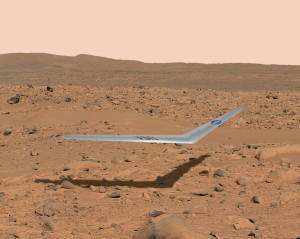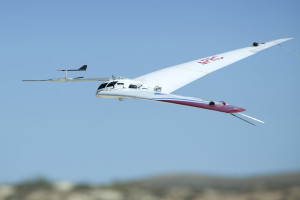
Illustration shows what a Prandtl-m might look like flying above the surface of Mars.
Credits: NASA Illustration / Dennis Calaba
A flying wing may be added to the tool kit for future exploration of the Red Planet.
An early design of such a craft is called the Preliminary Research Aerodynamic Design to Land on Mars, or Prandtl-m.
The concept, quite literally, is under the wing of a research group at NASA’s Armstrong Flight Research Center (AFRC) at Edwards, California.
Prandtl-m is planned to be ready for launch from a high altitude balloon later this year.
The craft would be released at about at 100,000 feet altitude, a sky-high zone that simulates the flight conditions of the Martian atmosphere, said Al Bowers, NASA Armstrong chief scientist and Prandtl-m program manager.
CubeSat deployed
Tests here on Earth are validating how the aircraft works, leading to modifications that will allow it to fold and deploy from a 3U CubeSat in the aeroshell of a future Mars-bound rover.
There is the prospect that the CubeSat could find its way onboard the aeroshell/Mars rover piggyback stack for Red Planet exploration in 2022-2024.
Once deployed from the CubeSat, Bowers said that Prandtl-m would stretch its wings and fly in the Martian atmosphere, gliding down and coming to full stop atop the Martian landscape.
“It would have a flight time of right around 10 minutes. The aircraft would be gliding for the last 2,000 feet to the surface of Mars and have a range of about 20 miles,” Bowers said. The aircraft’s wingspan, when deployed, would measure 24 inches and weigh less than a pound, he said.
Landing site verification
The Prandtl-m could zoom over some of the proposed landing sites for a future crewed Mars mission, Bowers said, “and send back to Earth very detailed high resolution photographic map images that could tell scientists about the suitability of those landing sites,” Bowers noted in an AFRC press release.

Air time on Earth. The proposed Prandtl-m — “m” for Mars — is based on the Prandtl-d seen coming in for a landing during a flight test in June. The aerodynamics offer a solution that could lead to the first aircraft on Mars.
Credits: NASA Photo / Ken Ulbrich
The Flight Opportunities Program, which is managed at NASA Armstrong, has agreed to fund two balloon flights during the next several years and potentially a sounding rocket flight following that to demonstrate how the flier would work on Mars, Bowers said.
Sounding rocket test
Riding on a sounding rocket, the prototype Mars wing, packed inside a CubeSat, would be released at 450,000 feet.
Falling back into the Earth’s atmosphere as it approaches the 110,000-to-115,000-feet altitude range, the glider would deploy just as though it was over the surface of Mars.
“If the Prandtl-m completes a 450,000-foot drop, then I think the project stands a very good chance of being able to go to NASA Headquarters and say we would like permission to ride to Mars with one of the rovers,” Bowers said.

